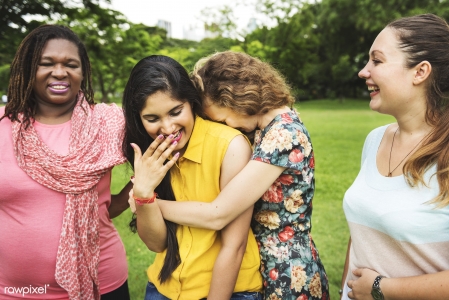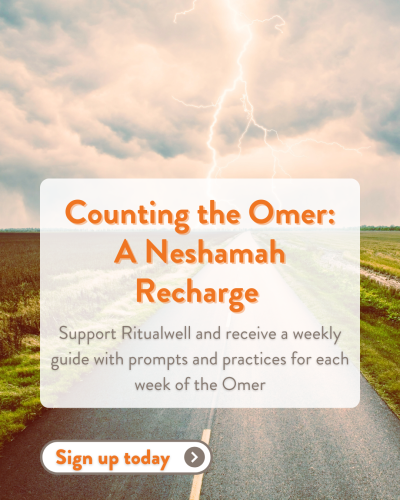Tu B’Av, the fifteenth of the month of Av, is an ancient Jewish holiday when women would go out to the fields in borrowed white clothing and dance. They would choose spouses from among the men who came to dance with them. Tu B’Av is also celebrated at the end of the Israelites’ forty years of wandering in the wilderness. This Tu B’Av ritual, created by Tamara Cohen and Rabbi Jill Hammer, is also appropriate for Rosh Chodesh Av, or for a Rosh Chodesh group that wants to celebrate later in the month.
Tu B’Av’s history includes matchmaking, dancing, and the celebration of the promise of new life and hope after fear and grief. Tu B’Av appears on the calendar between the communal mourning of Tisha B’Av, when we mark the destruction of the Temple, and the personal spiritual accounting of the High Holiday season. We suggest that this late summer holiday is an ideal opportunity for ritualizing the sharing we have always done as women – the telling of some of the intimate joys and pains of our lives. Of course, in our collective past, there have been some parts of our experiences of love that we have shared more freely than others. Indeed, it was the experience of breaking these silences and sharing fuller truths about love and sexuality that made the early years of the feminist movement so profoundly life-altering for many. It is our hope that this ritual will present a new context for this kind of sharing, a context that will lead to a greater sense among Jewish women and feminists that there is room within Judaism for all of our experiences, and that there is healing in coming together to share our experiences.
This ritual is intended for a group of friends, a women’s group or a Rosh Chodesh group that feels comfortable sharing with one another. An intergenerational group could be particularly powerful. The idea behind the ritual is that each year every one of us, regardless of where we are in our lives, experiences ups and down in our loving relationships. We are living in an era in which our possibilities for expressing love are perhaps wider than ever – thanks to the women’s movement, the gay, lesbian, bisexual and transgender movement, and modern science and technology. Yet, none of this necessarily makes love any easier.
While Tu B’Av is a celebration of love, many of us need something more than just celebration – we also need a space in which we can acknowledge the complexities of love – where a mother can share both the joys and pains she has experienced in the process of planning the marriage of her daughter or a son, where a single woman can laugh and cry about her experiences of dating, where a happily divorced woman and long-time partnered lesbian and a single mother and a newly dating grandmother can share together some of the wonders and trials of love as they experience it, long for it, mourn it, relish it, question it, fear it, and embrace it.
Participants should bring
- a small item that symbolizes something they would like to bury from their experiences with love over the past year.
- a piece of clothing, jewelry, or scarf that they have but no longer wear. These things will be “swapped” so everyone will go home with something different than what they came with.
Facilitator needs
- A basket or designated space for the donated clothing
- paper and pencils (and something hard to lean on for writing)
- a white tallit (prayer shawl)
- a plant, a pot and potting soil
- a cd or tape player
- copies of the verses from Lamentations and Jeremiah for all participants
1. Introduction
The facilitator thanks the group for coming and explains that the ritual has two basic parts, as it begins with mourning and moves toward dancing and celebration. She presents, in her own words, some of the ideas expressed above about the purpose of this Tu B’Av ritual and add anything she wants about her own apprehension and expectations. She may want to ask the group to agree on respecting the confidentiality of anything shared during the evening. She can then invite someone to read the following.
2. Voicing our Loss
Reading:
We have just completed Tisha B’Av, when the book of Lamentations is read. While Tisha B’Av commemorates communal tragedies, one of the voices of the Book of Lamentations is that of a woman whose powerful words express many levels of individual loss. Tonight we will use her words as our refrain in this first section of our ritual. Let us recite them together now, allowing this ancient poetry to evoke in us any feelings of loss we have experienced over the past year.
Group recites together
| Al elleh ani bokhiyah Eyni eyni yorda mayim Ki rakhak mimmenni m’nakhem Meyshiv nafshi “For these things do I weep, |
| —Lamentations 1.16 |
3. Writing
The facilitator then introduces the next section of the ritual: five minutes of free writing during which everyone is invited to explore her experiences of loss of love during the past year. This can include anything from the death of loved ones, to break-ups, to changing relationships with parents, children, friends, one’s own body and sexuality. Participants should be told at the beginning of the exercise that they will be given the opportunity to share what they write, to share part of it, or to keep it private. The facilitator should keep track of the time and warn participants when they have two minutes left.
4. Sharing
The facilitator explains that each participant will now take a turn to share her writing, word or phrase. She will indicate that she is done by putting her giveaway object into the basket, and her burial object into the planting pot. The facilitator can explain that there is a tradition that explains Tu B’Av as a holiday during which we lay our griefs and fears into the earth, burying them as discarded parts of ourselves, or, perhaps, planting them in order to transform them into new sources of life.
To indicate that group has heard and accepted the words and gifts of the participant who has just spoken, the entire group should recite the verse from Lamentations between each participant’s turn. If there are more than six or seven people in the group, give everyone a time limit for speaking, and recite the Jeremiah verse once, after everyone has spoken.
5. Shedding the loss
After the last participant has shared her loss and placed her word or object into the pot, the facilitator of the ritual should invite everyone to lie down, if space permits. The facilitator can explain that this lying down is a symbolic re-enactment of the mystical vision of the Israelites who lay in the sand of the desert and shed all that was keeping them from being fully alive, every night, in order to rise whole and pure and ready to move forward. The facilitator can invite everyone to symbolically and/or physically shake off all they are ready to shed. She can then slowly rise and recite, in Hebrew or English:
מִנְעִי קוֹלֵךְ מִבֶּכִי, וְעֵינַיִךְ, מִדִּמְעָה: כִּי יֵשׁ שָׂכָר לִפְעֻלָּתֵךְ
עוֹד תַּעְדִּי תֻפַּיִךְ, וְיָצָאת בִּמְחוֹל מְשַׂחֲקִים
| Min’i kolekh mibbekhi V’einayikh middim’ah Ki yesh sakhar lif’ullatekh Od taddi tuppayikh “Restrain your voice from weeping, |
| —Jeremiah 31:15 |
| “Again you shall take up your drums and go forth to the rhythm of the dancers.” |
| —Jeremiah 31: 3 |
The facilitator can then tap the shoulder of another and help her up. She then reads aloud the verse from Jeremiah and rouses the next woman, and so on. If the group is large, recite the verse once and ask everyone to rise at her own pace.
6. Naming Our Love
When all have been gently roused and welcomed to their feet, the group should stand in a circle. The facilitator can ask everyone to think of as many positive words associated with love as they can and invite everyone to share by completing the phrase “Love is…”
7. Planting and Blessing
The facilitator can then invite everyone to lift the plant into the pot and packs soil around it. The tallit can be held over everyone and, if desirable, the group can recite shehechiyanu, the prayer over a happy occasion.
Recite together: Let us grow new lives out of our losses. Let us remember how the people Israel emerged from the harsh wilderness into a land flowing with milk and honey. Let us celebrate together the many possibilities for love in our lives.”
8. New Clothes and Renewed Hope
The leader then invites everyone to select a garment, scarf or piece of jewelry from the basket. As someone selects a gift she should say what blessings or dreams of love she wishes for in the coming year. When the last person has spoken everyone joins together and loudly proclaims:
Ken Yehi Ratzon. May it be so!
Celebratory dancing and a festive meal can follow.
At the end of your ritual or during your meal, or as a separate project, you may want to collect tzedakah (money for justice) for women who cannot obtain the privileges of marriage. The Mishnah relates that “The girls would go out in white clothes which they borrowed one from the other, in order not to embarrass girls who did not have white clothes.” Some young women, those with more economic privilege, were seen, in their time period, as having better prospects for marriage. This inequality was symbolically redressed on Tu B’Av through the exchange of white clothes.
We too can address inequity by contributing to those working to extend the privilege of marriage to all women and men who want to enter legally sanctioned unions. Invite your participants to take action to promote justice for women in relationships. The National Gay and Lesbian Task Force 202.332.6483 www.ngltf.org and The National Center for Lesbian Rights 415.392.6257 www.nclrights.org work to obtain marital rights for gay and lesbian couples, who cannot legally marry. Agunot, women who are bound by religious marriage contracts to ex-husbands who refuse to grant them gets (Jewish bills of divorce), are also denied the right to marry. There are organizations in North America and Israel working to give these women the freedom to remarry and carry on with their lives. To find out more, call the Jewish Orthodox Feminist Alliance (JOFA) at (212) 752-7133 and buy an Agunah Solidarity Pin, or ask for a recent newsletter in which they list a number of organizations working to free agunot. Contact the Center for Women in Jewish Law www.schechter.edu/women/law.htm to learn about agunot in Israel, or look for information on the website of the International Jewish Women’s Human Rights Watch: www.icjw.org.uk.
Printed in Ma’yan’s Journey Spring 2002













